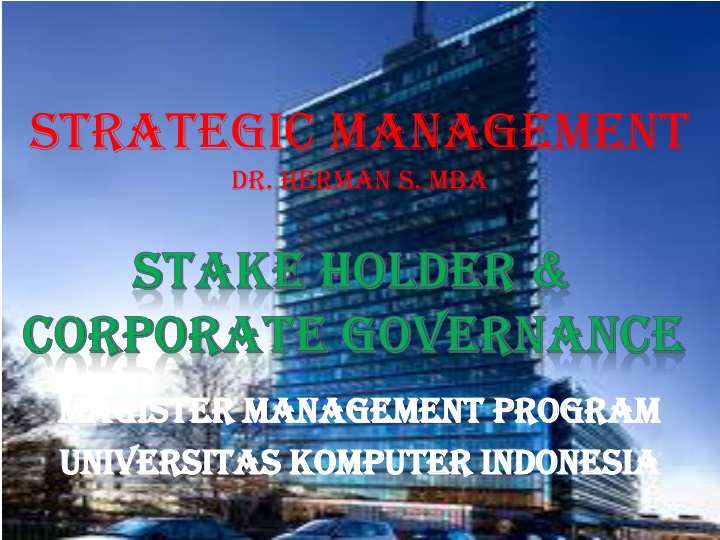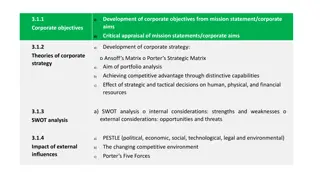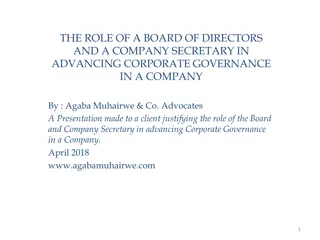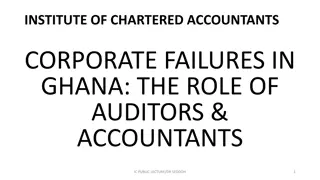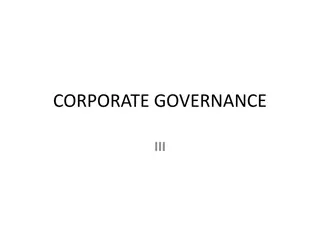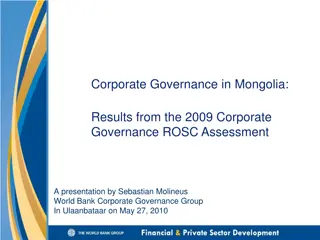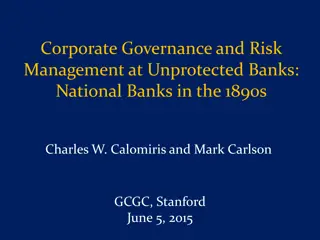Strategic Management and Corporate Governance Overview
This content provides an overview of strategic management, stakeholder involvement, corporate governance, and the roles and responsibilities of the board of directors in shaping corporate direction and performance. It discusses key concepts such as stakeholders, corporate governance monitoring, board composition, theories in corporate governance, and criteria for board member selection.
Download Presentation

Please find below an Image/Link to download the presentation.
The content on the website is provided AS IS for your information and personal use only. It may not be sold, licensed, or shared on other websites without obtaining consent from the author.If you encounter any issues during the download, it is possible that the publisher has removed the file from their server.
You are allowed to download the files provided on this website for personal or commercial use, subject to the condition that they are used lawfully. All files are the property of their respective owners.
The content on the website is provided AS IS for your information and personal use only. It may not be sold, licensed, or shared on other websites without obtaining consent from the author.
E N D
Presentation Transcript
STRATEGIC MANAGEMENT DR. HERMAN S. MBA STAKE HOLDER & STAKE HOLDER & CORPORATE GOVERNANCE CORPORATE GOVERNANCE Magister Management Magister Management Program Universitas Komputer Indonesia Universitas Komputer Indonesia Program
STAKEHOLDER All individuals or groups who have an active stake in the corporate and can potentially impact, either positively or negatively, its development.
Corporate Governance Defined: Refers to the relationship among the board of directors, top management, and shareholders in determining the direction and performance of the corporation. 4
BOARD OF DIRECTOR RESPONSIBILITIES Setting corporate strategy, overall direction, mission, or vision. Hiring & firing the CEO and top management. Controlling, monitoring, or supervising top management. Reviewing and approving the use of resources. Caring for shareholders interest.
Corporate Governance Monitor Developments inside and outside the organization Evaluate & Influence Review proposals, advise, provide suggestions and alternatives Board of Directors Initiate & Determine Delineate corporation s mission and specify strategic options 6
Board of Directors Members: Inside directors Management directors Officers or executives employed by corporation Outside directors Non-management directors May be executives of other firms but not employed by board s corporation 7
THEORY IN CORPORATE GOVERNANCE AGENCY THEORY STEWARDSHIP THEORY
Board of Directors Nominations & Elections Criteria for Selection Wiling to challenge management Special expertise Availability for advice and meetings Expertise on global issues Understands key technologies External contacts valuable to the firm Detailed knowledge of industry High visibility in field Accomplished in representing firm to stakeholders Board of Director Criteria 9
DEGREE OF INVOLVEMENT IN STRATEGIC MANAGEMENT Phantom Rubber stamp Minimal Reviewer Nominal Participation Active Participation Catalyst
Responsibilities of Top Management: Provide executive leadership and a strategic vision Manage the strategic planning process 12
Social Responsibility Friedman s Traditional View There is one and only one social responsibility of business to use its resources and engage in activities designed to increase its profits so long as it stays within the rules of the game, which is to say, engages in open & free competition without deception or fraud . 13
Social Responsibility Source: Adapted from A.B. Caroll, A Three Dimensionl Conceptual Model of Corporate Performance, Academy of Management Review (October 1979), P. 499. 14
http://t1.gstatic.com/images?q=tbn:ANd9GcRUIkLciRPipsFoUBOrr9cbLlI2qpqiNrvlJWTZrWfOzt7qBlUUq5GHLt8http://t1.gstatic.com/images?q=tbn:ANd9GcRUIkLciRPipsFoUBOrr9cbLlI2qpqiNrvlJWTZrWfOzt7qBlUUq5GHLt8
